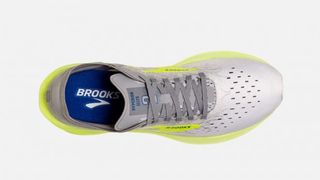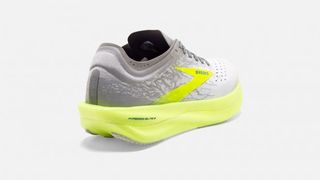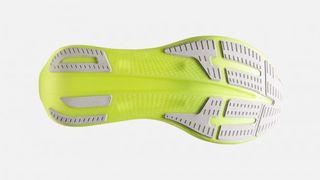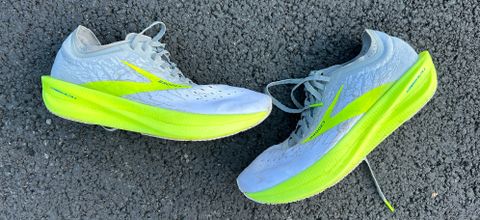Our Verdict
Thanks to a higher stack and a new midsole foam, the Hyperion Elite 2 is a major improvement on the original, and it offers a fast ride that’s more stable than many rivals, though it lacks the bounce of shoes like the Nike Vaporfly.
For
- Big improvement on original Hyperion Elite
- Fast and stable ride
- Carbon plate for improved efficiency
Against
- Midsole foam less soft and bouncy than rivals
- Collar can rub the achilles
- High price pits it against better racing shoes
You can trust Coach
When I tried the first Brooks Hyperion Elite early in 2020, it made me wonder if any company would be able to challenge Nike’s dominance of the racing shoe market.
None of the shoes with carbon plates that I had tested by that point came close to the performance levels of Nike’s record breaker, which I had used for all of my important races in 2019. The Hoka Carbon X was great on long runs, but much heavier and not as quick as the Vaporfly NEXT%, so it felt like more of a training option.
And the Hyperion Elite? It was a complete miss. It had the harsh firm ride of a racing flat, made harsher and firmer by the plate, and none of the joyful bounce of the Vaporfly. To top it off, it cost £210 and Brooks said it would only perform at its best for 80-160km.
Since then I’ve tried some excellent shoes with carbon plates, such as the Saucony Endorphin Pro, which give Nike a run for its money. And after a range of runs in it, I reckon the second iteration of Brooks’ Hyperion Elite can do so too.
The essential difference between editions of the Hyperion Elite is the foam used in the midsole, which has changed from DNA Zero to DNA Flash. Apart from being slightly heavier, DNA Flash proved superior to Zero in every way, offering a faster and much more springy ride.
The weight difference is hardly overwhelming either. The first Hyperion Elite weighted 205g in my UK size 9, the Elite 2 weighs 223g – a price well worth paying for the improved ride.
I’ve used the Elite 2 for several runs, mostly focusing on fast stuff to see if it has the pace to compete with the best racing shoes. My first outing was a hard track session running four 2km reps at a mix of paces, followed by an hour-long run progressing from easy to steady pace. After that the most notable run I did was a 10K alternating 3min 50sec/km and 3min 20sec/km pace.
It was surprisingly good on the track even when I went faster than my 5K pace, and the extra cushioning compared with a flat meant I finished the session strong. Do bear in mind, however, that new guidelines on stack height mean the Elite 2 won’t be allowed in track races.
The Elite 2 felt even better on the hour-long easy to steady run, a session I ran based on heart rate. I was consistently surprised at the pace my watch was throwing up for the effort I was putting in. Once again, I felt strong at the end of the run thanks to all that cushioning underfoot, plus the extra impetus from the carbon plate. It was the same on the speedy 10K, where I rolled through the run comfortably and felt like I had plenty to give at the end.

Based on this the Elite 2 will be a terrific road racing option and it’s one that offers a different feel from other super-shoes. The Brooks shoe isn’t very soft and springy like Nike and New Balance’s racers, nor does it have the smooth heel-to-toe roll of Saucony’s Endorphin Pro. It feels more natural on the foot and is more stable too, owing to the firmer feel and the very wide forefoot on the shoe.
At first the somewhat normal feel of the Elite 2 might make you think that it doesn’t merit super-shoe status. It doesn’t feel like anything special, really. Once you try to run fast in it, however, you’ll realise you’re mistaken: this is a very fast shoe and one that will work for a wide range of runners.

I found that the Hyperion Elite 2 fit true to size and the toe box is comfortably roomy even with a tight, locked-down fit around the midfoot. The upper is very thin and lightweight, though there’s a little extra cushioning around the heel to protect your achilles.
When I ran in the shoe several days in a row I found that the cushioning around the achilles did start to rub uncomfortably, but that didn’t occur when I only used it once a week. I wouldn’t let this put you off because this isn’t a shoe to use every day.
One reason for that is the outsole features very little in the way of rubber to protect the midsole foam – this is a road racing shoe and isn’t suited to gravel paths or even the lightest of trails. My second run in the Elite 2 featured a heavy shower and I could feel a little slippage on wet pavements, although nothing so drastic that it put me off my stride. I might opt for the exceptionally firm-gripping Asics Metaracer instead for a wet 5K or 10K though.
With the change in midsole foam comes an increase in the expected lifespan of the shoe too and Brooks has suggested the Elite 2 will last 320km. However, I’ve logged a lot of miles in the Hyperion Tempo and the Brooks Catamount trail shoe – both of which also use DNA Flash foam – with real no signs of wear and tear, I’m cautiously confident the Elite 2 will last longer than that estimate.

The Brooks Hyperion Elite 2 is a huge upgrade on the first Hyperion Elite, and a shoe that is right up there with the best carbon racers available. However, it’s not enough just to be an amazing shoe in 2020 with so many outstanding options available. If I had a target marathon tomorrow, I would still lean towards the Alphafly or Vaporfly, and if you already have the Vaporfly then it’s not worth splashing the cash on the Elite 2.
It’s also more expensive than the Saucony Endorphin Pro and Adidas Adizero Adios Pro shoes, which I consider as good as the Elite. That said, I do think the Elite 2’s stability is a feature that other super-shoes don’t offer, which might make it the right choice for runners who don’t enjoy the soft feel of racers like the Vaporfly.
- The Best Carbon Plate Running Shoes
- The Best Running Shoes
- The Best Marathon Running Shoes For Training And Racing

Nick Harris-Fry is a journalist who has been covering health and fitness since 2015. Nick is an avid runner, covering 70-110km a week, which gives him ample opportunity to test a wide range of running shoes and running gear. He is also the chief tester for fitness trackers and running watches, treadmills and exercise bikes, and workout headphones.

